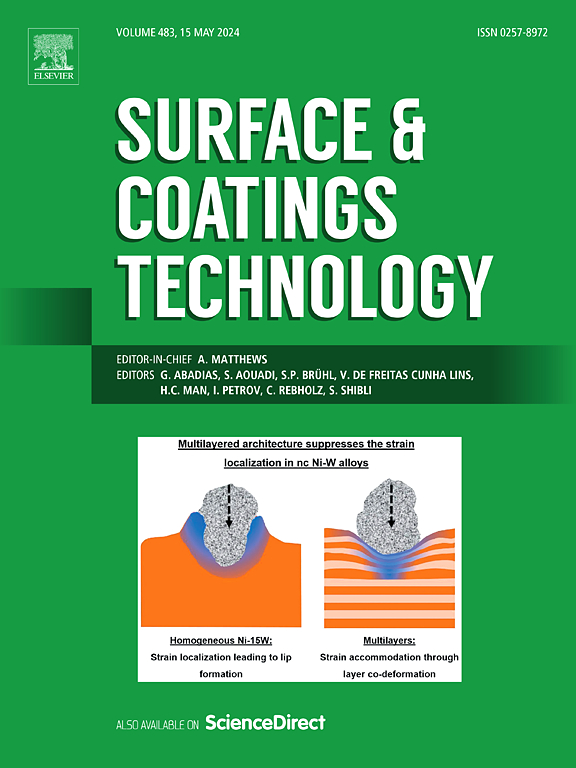一步微弧氧化原位制备Al2O3-CePO4-MoS2复合材料层的显微组织、磨损和腐蚀行为
IF 5.3
2区 材料科学
Q1 MATERIALS SCIENCE, COATINGS & FILMS
引用次数: 0
摘要
采用微弧氧化技术在6082-T6合金表面原位制备了Al2O3-CePO4-MoS2复合层。研究了Ce3+浓度对三元层微观组织、磨损和腐蚀行为的影响。结果表明,当电解液中Ce3+浓度为7.5 g/L时,最高硬度为961.79 HV1,摩擦系数为0.56,磨损率为4.9 × 10-7 mm3/N·mm,自腐蚀电流密度降低了一个数量级,腐蚀坑明显减小。Al2O3-CePO4-MoS2层的耐磨损和耐腐蚀性能优于Al2O3-MoS2层。原位形成的结晶或非晶态CePO4和MoS2在Al2O3周围形成,并具有协同作用,提高了材料的致密性、硬度、耐磨性和耐腐蚀性。这种Al2O3-CePO4-MoS2复合层可用于在雨天环境中保护触点系统。本文章由计算机程序翻译,如有差异,请以英文原文为准。
Microstructure, wear, and corrosion behavior of an Al2O3-CePO4-MoS2 composite layer in-situ prepared by one-step micro arc-oxidation
The Al2O3-CePO4-MoS2 composite layer was in-situ prepared on the surface of 6082-T6 alloy by micro-arc oxidation technology. The effects of Ce3+ concentrations on microstructure, wear and corrosion behavior of the ternary layer were studied. The results showed that when the Ce3+ concentrations in electrolyte was 7.5 g/L, the highest hardness was 961.79 HV1, the friction coefficient was 0.56 and wear rate was 4.9 × 10-7 mm3/N·mm, the self-corrosion current density was reduced by one order of magnitude, and the corrosion pit was significantly reduced. The wear and corrosion resistance of the Al2O3-CePO4-MoS2 layer is better than that of Al2O3-MoS2 layer. The crystalline or amorphous CePO4 and MoS2 formed in-situ were presented around the Al2O3 and had synergistic effects for improving the compactness, hardness, wear, and corrosion resistance. This Al2O3-CePO4-MoS2 composite layer can be used for protection in contact systems in rainy environments.
求助全文
通过发布文献求助,成功后即可免费获取论文全文。
去求助
来源期刊

Surface & Coatings Technology
工程技术-材料科学:膜
CiteScore
10.00
自引率
11.10%
发文量
921
审稿时长
19 days
期刊介绍:
Surface and Coatings Technology is an international archival journal publishing scientific papers on significant developments in surface and interface engineering to modify and improve the surface properties of materials for protection in demanding contact conditions or aggressive environments, or for enhanced functional performance. Contributions range from original scientific articles concerned with fundamental and applied aspects of research or direct applications of metallic, inorganic, organic and composite coatings, to invited reviews of current technology in specific areas. Papers submitted to this journal are expected to be in line with the following aspects in processes, and properties/performance:
A. Processes: Physical and chemical vapour deposition techniques, thermal and plasma spraying, surface modification by directed energy techniques such as ion, electron and laser beams, thermo-chemical treatment, wet chemical and electrochemical processes such as plating, sol-gel coating, anodization, plasma electrolytic oxidation, etc., but excluding painting.
B. Properties/performance: friction performance, wear resistance (e.g., abrasion, erosion, fretting, etc), corrosion and oxidation resistance, thermal protection, diffusion resistance, hydrophilicity/hydrophobicity, and properties relevant to smart materials behaviour and enhanced multifunctional performance for environmental, energy and medical applications, but excluding device aspects.
 求助内容:
求助内容: 应助结果提醒方式:
应助结果提醒方式:


